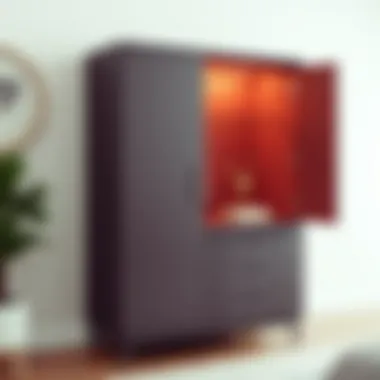Exploring the Modern Armoire Dresser Design and Trends


Intro
In the dynamic world of furniture, the modern armoire dresser stands out as an impressive blend of style and practicality. Its design has evolved significantly over the years, reflecting not just changing tastes but also adapting to various lifestyles. The armoire's versatility makes it an essential piece for any room in the home. This article will explore its journey from traditional roots to contemporary reinterpretations that cater to the desires of today’s homeowners, designers, and DIY enthusiasts.
As we navigate through this exploration, readers will uncover a wealth of insights into design trends, functionality, and key considerations during the buying process. From understanding how to make informed choices about materials, finishes, and styles, to discovering ways to maintain and integrate these units seamlessly into living spaces, this guide is a treasure trove for anyone looking to enhance their home aesthetic. Prepare to delve deep into the nuances of modern armoires, ensuring that you stay one step ahead in your quest for furniture that not only looks good but also serves a purpose.
Furniture Design Trends
Current Styles and Aesthetics
The modern armoire dresser has become a canvas for various design influences, showcasing a blend of sophistication and creativity. Current trends tend to center around minimalism and functionality. Sleek lines, multifunctional designs, and clean silhouettes are all the rage.
Notably, Scandinavian design has captured many hearts with its emphasis on simplicity and natural materials. Imagine an armoire crafted from light oak with a pale finish – not just visually appealing but practical in a multitude of settings. On the other hand, industrial style has found its niche too, exhibiting rugged metal frames and distressed wooden surfaces.
Often you’ll see a marriage of these styles, where a classic wooden armoire features contemporary hardware or a bright pop of color, resulting in pieces that are both timeless and on-trend.
Color Palettes and Materials
When it comes to color, the modern armoire embraces a palette that reflects current aesthetics. Soft pastels like dusty rose, muted greens, and classic whites take center stage, creating calming environments. Meanwhile, rich jewel tones can add drama and depth, perfect for a statement piece.
Material choice also plays a crucial role in the modern armoire. From traditional hardwoods that evoke warmth, to engineered woods that allow for striking designs without the hefty price tag. Textures are also valuable; a combination of smooth finishes and textiles like linen-lined interiors enhances the tactile experience, making these pieces feel more inviting.
"Choosing the right materials and colors for your armoire isn't just about style; it's about creating a holistic environment in your home."
Buying Guides
Essential Considerations When Purchasing
A modern armoire can be a significant investment, so it's important to approach the purchase with thoughtful consideration. Factors to keep in mind include:
- Space Requirements: Measure your space carefully to ensure the armoire complements rather than overwhelms its surroundings.
- Functionality: Determine what you need the armoire to do. Will it primarily store clothes, or do you require extra space for books or other items?
- Style Consistency: Ensure it aligns with your existing decor - a cohesive look can elevate the aesthetic of any room.
- Durability: Seek high-quality materials that not only look good but will stand the test of time.
Top Recommendations for Different Budgets
Choosing the right armoire can vary greatly based on your budget. Here are a few recommendations:
- Budget-Friendly Options: Look for brands like IKEA or Wayfair that offer stylish pieces without breaking the bank.
- Mid-Range Selections: Consider stores like West Elm or Target, where you can find unique designs that don’t sacrifice quality.
- Luxury Choices: If you’re looking to invest, brands like Restoration Hardware or Ligne Roset provide exquisite craftsmanship and materials.
By understanding these trends and factors, you’ll be equipped to make decisions that resonate with your personal style while fulfilling practical needs. This journey through modern armoires not only illuminates the stylistic elements but prepares you for thoughtful selections in your future purchases.
Preamble to the Modern Armoire Dresser
The modern armoire dresser has become a significant presence in contemporary home design, combining style with practicality in ways that resonate with today's homeowners. As living spaces become increasingly versatile, the need for adaptable furniture grows. The armoire dresser, once merely a piece for clothing storage, has evolved into a multifunctional unit that caters to various needs, from stylish organization to aesthetic appeal. This article explores the many nuances surrounding this piece of furniture, shedding light on its design, functionalities, and the trends that define its place in modern homes.
Defining the Modern Armoire Dresser
In simple terms, a modern armoire dresser is a tall storage unit that merges the traditional armoire's wardrobe functions with the sleek and practical aspects of contemporary dressers. Unlike basic drawers or closets, the modern armoire typically features a combination of open shelves, drawers, and hanging spaces, accommodating textiles, clothes, and even decorative items with ease. This versatile piece often comes designed with clean lines and neutral colors, appealing to a wide variety of tastes while offering efficient organization.
Historical Background
Origin of the Armoire
Armoires trace back to the medieval period, originally crafted as large, ornate cabinets intended for storing valuable items. These substantial furniture pieces symbolized wealth and were often decorated with intricate carvings. The typical armoire of times past was heavy and cumbersome, crafted predominantly from sturdy hardwoods like oak or walnut.
Their primary purpose was functional — providing safe and secure storage. However, they transformed over the centuries, gradually becoming more streamlined and less monumental in their construction. This evolution plays a considerable role in their popularity today, as homeowners seek pieces that balance form and function without taking over the room.
Evolution Over the Centuries
Fast forward to the 18th and 19th centuries, and you see the armoire evolve into more than just a storage box. It transitioned from bulky designs to more refined silhouettes, integrating aesthetics with functionality. The introduction of lighter woods and metal fittings allowed for versatility, opening the door for innovation in design. In contemporary settings, the modern armoire dresser inherits this evolutionary spirit, merging historical craftsmanship with modern design sensibilities.
Particular features, such as ergonomic designs and customizable compartments, emerged in this era, addressing both practical needs and aesthetic preferences. This blend of historical roots and modern conveniences has made the armoire dresser a sought-after solution for urban dwellings and spacious homes alike, capturing the essence of modern living.
Key Features of a Modern Armoire Dresser
The modern armoire dresser stands at the intersection of both style and utility, serving diverse needs in today’s homes. Understanding its features is crucial for homeowners, designers, and DIY enthusiasts looking to elevate their living spaces. These key characteristics not only shape functionality but also dictate how well an armoire integrates into contemporary design schemes.
Design Aesthetics
Minimalist Approaches
Minimalism in armoire design leans heavily on simplicity and uncluttered surfaces. Sleek lines, neutral colors, and an overall airy feel can make a space appear larger than it is, creating an at-home environment that encourages calmness. Minimalist armoires often feature pared-down hardware, enhancing the sense of openness.


One of the key characteristics of this approach is its focus on quality over quantity. A well-crafted piece, made from sustainably sourced materials, can stand as a focal point while remaining understated. This simplicity is appealing for those seeking less visual clutter in their homes, positioning minimalist armoires as a beneficial choice for modern design.
However, a potential downside might come from their lack of ornate design elements, which could be seen as stark or bland for some tastes. Yet, in the context of a modern aesthetic, this can often work to a homeowner's advantage, providing a clean canvas upon which other decorative elements can shine.
Bold Statements
On the flip side, bold armoire designs actively invite attention. These pieces might incorporate striking colors, elaborate patterns, or unique shapes, aiming to create a conversation around them. A bold statement armoire can serve not only as a storage solution but also as an artistic expression.
Its characteristic is the use of eye-catching materials or unexpected forms, which can serve as the centerpiece in a room. Such armoirs celebrate individuality, making them an attractive option for those who wish to showcase their personalities through their decor.
However, while they can certainly grab attention, there’s the consideration of balance. A bold design can dominate a space if not paired thoughtfully with the surrounding furniture, which might overwhelm a more subdued interior setting. Successful integration calls for a keen understanding of proportion and color theory.
Functional Elements
Storage Solutions
The hallmark of any armoire is its ability to offer storage—sometimes ample space, sometimes cleverly organized. Modern storage solutions within armoires can be tailored for various needs, whether it’s for clothing, linens, or even home office essentials. Features such as adjustable shelving, pull-out drawers, and compartments can maximize usability.
This aspect also caters to different lifestyles. For example, a family might need extra space for children's clothes, while a single professional may prioritize the sleek packing away of work materials. The ability to adapt storage solutions offers a key benefit, making armoire dressers invaluable in setting up functional living spaces.
Nonetheless, the variety found in storage configurations can lead to decision fatigue for some buyers. Picking the right storage layout that suits personal needs is increasingly important.
Multi-Functionality
Lastly, multi-functionality is one of the standout features of modern armoires. These versatile pieces often go beyond traditional clothing storage, incorporating elements like built-in desks, dressing areas, or even hidden televisions. An armoire can transform from a mere storage unit into an entire organizational system for a room.
The appeal lies in maximizing space without sacrificing style. For those living in smaller homes or apartments, choosing an armoire that serves multiple purposes can be a smart move. The unique feature here is the versatility, allowing it to adapt to various uses as life changes—great for homes that shift in needs over time.
However, there’s a flip side to this flexibility. An armoire overloaded with functions can become complicated, leading to a cluttered or ineffective design if not executed well. It's essential for designers and homeowners to carefully consider how multi-functional elements are integrated to ensure aesthetic cohesion is maintained alongside utility.
Material Selection for Modern Armoires
When choosing a modern armoire dresser, the material selection plays a pivotal role in defining its durability, aesthetic appeal, and overall functionality. The materials not only influence the look of the furniture but also its longevity and care requirements. Selecting the right materials can seem like a daunting task, but understanding the characteristics of each option can simplify the process and elevate the quality of choices made.
Wood Varieties
Hardwoods vs. Softwoods
In the realm of armoires, distinguishing between hardwoods and softwoods is essential. Hardwoods, like oak or cherry, are known for their durability and dense grain, making them a long-lasting investment. These types of wood are typically more resistant to wear and tear, which is a valuable characteristic for a piece that endures daily use. On the flip side, softwoods such as pine or cedar offer a lighter and often more affordable option, particularly appealing for those on a budget.
One of the key considerations in this comparison is the finish; hardwoods tend to take stains and paints exceptionally well, allowing for a variety of design options. In contrast, the subtle grain of softwoods can sometimes limit stain finishes but can present a beautiful natural look if left unvarnished. Each has unique features that cater to different styles and preferences, ultimately contributing to the character of the armoire.
Sustainable Wood Choices
The relevance of sustainable wood choices can't be overstated in today's environmentally-conscious market. Sourcing wood that is certified by organizations like the Forest Stewardship Council (FSC) assures consumers of responsible harvesting practices. Sustainable wood choices not only promote eco-friendly practices but often showcase unique characteristics such as distinctive grain patterns or local sourcing, making them a favorite among homeowners who value originality.
One significant advantage of choosing sustainable materials is their positive impact on the environment. This choice can lead to reduced carbon footprints and support for reforestation efforts, aligning perfectly with modern values. It does come with considerations, however; sustainable woods may come at a premium cost, but the benefits in terms of durability and environmental consciousness often outweigh the initial price.
Metal and Glass Accents
Contemporary Trends
The incorporation of metal and glass accents has added a fresh twist to modern armoires, pushing the boundaries of traditional design. Contemporary trends favor a mix of materials, combining the warmth of wood with the sleekness of metals and the transparency of glass. This combination can enhance the design by creating visual interest and depth, making the armoire not just a storage unit, but a statement piece in any room.
One notable characteristic of these trends is their versatility; for instance, brushed nickel for hardware or frosted glass doors can create a sleek, modern charm, while polished brass might add a touch of vintage glam. Balancing these elements offers a captivating contrast that elevates the overall aesthetic of living spaces.
Combining Materials
Exploring combining materials allows for endless creativity in armoires. The fusion of wood, metal, and glass can lead to striking designs that fulfill both functional and stylistic desires. For example, an armoire featuring a wooden frame with glass panels and metal handles brings an intriguing balance between different textures and visual elements.
The ability to customize through material combinations adds uniqueness to each piece. However, while combining materials can provide aesthetic appeal, it also calls for careful consideration regarding the harmony of design. Ensuring that materials complement rather than clash with each other is crucial for achieving a cohesive look.
"Material selection reflects personal style as much as it does the functionality and sustainability desired for a home."
In summary, the choice of materials for modern armoires profoundly impacts both their functionality and design. Understanding the distinctions among wood types, the importance of sustainability, and the appeal of mixed materials can significantly enhance the decision-making process for anyone seeking to invest in quality furniture.
Customization Options for Armoires
Customization is at the heart of modern armoire dressers, allowing homeowners to create pieces that not only complement their personal style but also meet their operational needs. The beauty of customization lies in its flexibility, enabling individuals to tailor designs to fit spaces, aesthetics, and even lifestyle requirements. This section will cover various avenues for customization, including tailored designs, sizes, and configurations.
Tailored Designs
Color Choices


Color plays a significant role in defining the overall character of an armoire. It can brighten a room or provide a sense of warmth and comfort. Customizing color choices allows you to ensure that the armoire harmonizes with existing decor and personal tastes. The key characteristic of color customization is its vast spectrum, ranging from earthy tones to vibrant hues. This variety makes it a popular choice for many homeowners who see their furniture as an extension of their personality.
One unique feature of color customization is its ability to enhance mood. Warm colors can evoke feelings of coziness, while cool shades might create a tranquil atmosphere. However, this approach does come with challenges; certain colors may fade over time or may not suit all styles.
Hardware Selections
Hardware selections, including handles, knobs, and hinges, also influence the armoire's final look. This aspect contributes significantly to the overall style, whether one opts for sleek, modern finishes or antique looks. The key characteristic of hardware customization is its usability and aesthetic potential. This makes it a beneficial choice for those desiring both functionality and style.
Selecting the right hardware can elevate a simple armoire into a stunning focal point. However, the downside might be the time needed to find hardware that precisely fits your vision, as not all designs are available in every style or finish.
Size and Configurations
Compact Alternatives
For those living in smaller spaces, compact alternatives are a vital consideration. These designs maximize utility while preserving essential floor space; they are particularly beneficial for city dwellers. Compact armoires often feature multi-functional elements, such as built-in mirrors or shelves that extend their usability beyond basic storage. By emphasizing efficiency, these alternatives make it easier to keep rooms organized without sacrificing style.
However, a challenge comes with these designs; limited space can restrict storage capabilities. Therefore, evaluating what essentials need to be stored is crucial.
Maximizing Space in Smaller Rooms
Maximizing space in smaller rooms is all about creative solutions. Modern armoires can come with adjustable shelves or sliding doors, providing flexibility in organizing contents. The key characteristic of these designs is adaptability, which allows them to fit into diverse layouts and room arrangements. This adaptability is quite popular among homeowners who value the practical use of every square foot.
A unique aspect of maximizing space effectively is the possibility of incorporating design elements like mirrors or lighting, enhancing aesthetics while providing practical solutions. However, it is necessary to measure carefully; if not done right, a poorly sized armoire can make a small room feel even cramped.
Ultimately, the art of customizing an armoire dresser hinges on understanding both your design preferences and functional requirements. Striking a balance between form and function is key to creating a timeless piece that fits seamlessly into contemporary living.
Trends in Modern Armoire Dressers
The modern armoire dresser showcases how design and function collide, revealing a magnificent tapestry of influences and styles. Today’s trends embrace a multitude of aspects that reflect changing tastes, environmental sensitivity, and practical needs. Homeowners are not just looking for storage solutions; they want pieces that resonate with their personal style and lifestyle demands.
In understanding trends in modern armoires, you can see how current market forces shape design philosophies. From minimizing environmental impact to enhancing everyday living through thoughtful design, each trend contributes positively to the way we perceive and utilize these versatile furniture pieces.
Current Styles in the Market
Scandinavian Influence
The Scandinavian influence in modern armoires mirrors the larger mid-century movement, emphasizing simplicity and functionality. One key characteristic is their use of clean lines, engaging natural materials, and a soft color palette that often feels airy. This style promotes a calm, uncluttered space - a vital component in creating a personal oasis amid a chaotic world.
The unique feature of Scandinavian armoires is their lack of excessive ornamentation. Instead, they favor minimalism which is beneficial for small living spaces, allowing light to flow freely and creating an inviting atmosphere. However, the disadvantage may lie in its tendency to look too austere for some; thus, mixing textures and colors can help create a more warmth-filled environment.
Industrial Design Elements
On the flip side, the industrial design elements focus on rugged, raw materials that evoke a sense of permanence and strength. A hallmark of this style is the incorporation of metal accents, which provide a bold contrast to wooden frameworks. This characteristic has become a popular choice for those who appreciate the blend of modernity and historical charm.
One distinct feature of industrial armoires is their emphasized utilitarian aspects and exposed functionality, which adds an edgy flair to any space. While this might create an inviting buzz in an open loft-style apartment, the sharp edges and harsher materials could make it less suitable for cozy, traditional interiors where soft furnishings are key.
Eco-Friendly Choices
Reclaimed Materials
The move towards reclaimed materials in furniture production is not only a fashionable choice but also a significant step towards sustainability. Not only does using reclaimed wood reduce waste, but it also gives each piece a unique history and character. This type of material is environmentally friendly and often results in distinctive finishes that add character to any space.
Reclaimed armoires can have a rustic charm or a more polished aesthetic, depending on how they are designed. While durability is a strong suit of this approach, some might find it harder to match these unique characteristics with contemporary décor unless carefully curated, requiring a discerning eye for complementary styling.
Ethical Production Practices
Lastly, the focus on ethical production practices is gradually reshaping the furniture industry landscape. This trend promotes transparency in the manufacturing processes and encourages sourcing materials from responsible suppliers who prioritize fair labor rights. The defining aspect of ethical production is cultivating trust between consumers and manufacturers.
By purchasing from brands that uphold ethical practices, homeowners can feel good about their choices, knowing they're supporting eco-conscious and socially responsible efforts. However, products made through these practices might come at a premium price, which could deter budget-conscious buyers. Yet, the long-term value of investing in responsibly-made items can outweigh initial costs, enhancing not just the living space but the broader community as well.
"In choosing modern armoires, consumers are starting to think beyond just aesthetics; they are becoming conscious of the impact of their choices on the world around them."
So, as we plunge into the depths of armoires, these trends unravel a narrative that speaks to personal expression, environmental consciousness, and a desire for functionality paired with style.
Care and Maintenance of Armoires
Caring for and maintaining armoires is not simply a matter of good housekeeping; it holds significant importance in ensuring the longevity and functionality of these intricate pieces of furniture. Armoires often serve as focal points in a room, offering both visual appeal and invaluable storage solutions. Neglecting their care can result in dull finishes, structural dilemmas, and even irreparable damage. Through proper maintenance, homeowners can preserve the beauty and utility of these units while safeguarding their investment.
Cleaning Methods
Regular Care Tips


Regular care of armoires usually involves straightforward cleaning techniques that help maintain their aesthetic allure. Dusting is fundamental; using a soft, lint-free cloth can help prevent dust accumulation, which, if left unchecked, may lead to scratches and a dulled appearance.
- Key characteristic: The simplicity of this method is appealing. Regular dusting takes hardly any time and can be incorporated into routine cleaning schedules.
- Unique feature: The real beauty of simple care practices like dusting and wiping with a damp cloth lies in their effectiveness. They remove dirt without damaging surfaces.
- Advantages: This method is essentially cost-effective, requiring no specialized products, thus making it a popular choice for many. However, it requires consistency to ensure furniture maintains its charm.
Addressing Scratches and Wear
Over time, all armoires might experience scratches and wear, directly impacting their charm and utility. Knowing how to address these imperfections becomes crucial.
- Key characteristic: Using touch-up markers or wood fillers can restore the finish and prevent further damage.
- Unique feature: Many options come in colors that match popular wood finishes, making repairs seamless and almost invisible.
- Advantages: This method is beneficial in keeping your armoire looking its best without having to refinish the entire piece. On the downside, some techniques may not provide the durability needed for high-traffic areas, requiring even more care.
Long-Term Preservation
Avoiding Damage from Humidity
Humidity can wreak havoc on wooden furniture, including armoires. Excess moisture can cause warping and mold growth, which are detrimental to longevity. Thus, understanding how to minimize humidity's effects is vital.
- Key characteristic: Investing in a dehumidifier can effectively control humidity levels, particularly in areas prone to dampness.
- Unique feature: Some homeowners opt for moisture absorbers, which can be quite effective in smaller, enclosed spaces.
- Advantages: These approaches ensure the integrity of the wood while minimizing the risk of mold, however, they may require ongoing monitoring and maintenance to be truly effective.
Proper Storage Practices
When it comes to larger pieces of furniture like armoires, knowing how to store items properly inside can greatly affect the durability of the unit itself.
- Key characteristic: Organizing items to prevent heavy loads on shelves can maintain structural integrity.
- Unique feature: Utilizing dividers or boxes inside the drawers can also prevent clutter, making it easier to access belongings.
- Advantages: This results in an overall longer lifespan for both the armoires and the items housed within them. The drawback, however, is that maintaining organization requires diligence which can sometimes be neglected in daily life.
"The charm of an armoire resides not just in its capacity, but in how well it's maintained, weaving stories through its endurance."
In summary, caring for and maintaining armoires involves a thoughtful approach that encompasses both cleaning methods and long-term preservation strategies. Solid knowledge of this topic fosters a deeper appreciation for these beautiful pieces while ensuring they serve their purpose and remain a stunning feature in modern homes.
Integrating Armoires into Home Design
Integrating armoires into home design is a surefire way to elevate both the functionality and aesthetic appeal of your space. These versatile pieces of furniture serve not just as storage units but also as integral design elements that shape the character of a room. When seamlessly incorporated into various settings, armoires can enhance the overall flow and ambiance, catering to the dynamic needs of modern lifestyles.
Placement in Different Rooms
Bedrooms
The bedroom is perhaps the most traditional setting for an armoire, and rightly so. These pieces allow for organized storage while contributing to the room's overall charm. The grand stature of an armoire in a bedroom offers an inviting visual that just beckons relaxation. One key characteristic here is that armoires can act as statement pieces, often boasting stunning craftsmanship, whether that's intricate carvings or sleek, modern lines.
Substituting bulky dressers with a well-placed armoire can free up floor space, creating a more spacious feel. They also tend to be advantageous in terms of style versatility, easily geling with various decor themes. However, it’s crucial to consider the size of the armoire in relation to the room; a massive unit in a compact space can overwhelm the ambiance, making it feel cramped.
Living Areas
In living areas, an armoire can transition seamlessly from a functional storage unit to an eye-catching display. Instead of seeing it as just a bland storage solution, it can house books, games, or even a TV, depending on its design. The modern armoire’s unique feature is its ability to blend utility with style, serving as both a practical solution and a focal point in the room.
One of the main advantages here is the opportunity for trendy customization. You can choose an armoire that resonates with your style—perhaps something rustic to match wooden accents or a sleek glass-front design for a contemporary look. However, one must keep in mind that it could either stand out beautifully or clash if the existing furniture is significantly mismatched in style.
Complementing Existing Furniture
Creating Cohesive Styles
Creating cohesive styles is a vital aspect of any interior design endeavor. An armoire can act as the glue that ties various elements together. Whether you’re aiming for a vintage look or modern minimalism, selecting an armoire that shares common traits with your existing pieces amplifies harmony throughout the space. This approach allows for a design narrative that flows effortlessly from one corner of the room to another.
The key here is the ability to harmonize colors, finishes, and textures. This attention to detail is beneficial as it can turn an ordinary setup into a well-planned sanctuary. However, one must tread carefully; overmatching can lead to a monotonous look, dulling the overall charm of the room.
Balancing Proportions
Balancing proportions is a concept often overlooked when placing armoires in a room. An oversized armoire can dwarf smaller furniture pieces, leading to awkward visual dynamics. Conversely, a too-small armoire can get lost in a vast space. The aim should be to strike a balance that feels intentional and pleasing to the eye.
When you achieve this balance, the entire visual landscape of a room transforms. A properly proportioned armoire serves to create pleasing silhouettes, allowing for a smoother visual flow. This careful consideration is what makes integrating an armoire into a space not just functional, but truly transformative.
Closure: The Modern Armoire Dresser's Role in Contemporary Homes
As we wrap up our exploration of the modern armoire dresser, it becomes clear that this piece is more than just furniture; it’s a harmonious blend of style and functionality that adapts to the diverse needs of contemporary living. The relevance of the modern armoire extends beyond its aesthetic appeal to encompass several essential aspects that enhance the functionality and character of homes today.
Summary of Key Points
The modern armoire dresser stands out due to its:
- Versatility: Acting as both a storage solution and a design statement, it can fit within various styles, from minimalist to elaborate.
- Customization: Homeowners can tailor their armoires to meet personal preferences in color, size, and features, allowing for unique expressions of style.
- Material Options: The choice of wood, metal, and glass allows for durability while maintaining a sleek look, catering to modern sensibilities of sustainability and environmental consciousness.
- Integration: Positioned well in different living spaces, armoires can elevate the overall design without overpowering existing furnishings.
In summary, this piece can significantly contribute to easing clutter while maintaining a sophisticated ambiance in any room.
Final Thoughts on Future Trends
Looking ahead, the evolution of the modern armoire dresser will likely be influenced by ongoing shifts in design trends and societal needs. Key trends to watch include:
- Smart Features: With technology increasingly infiltrating our homes, expect armoires to integrate smart features, allowing homeowners to control lighting, temperature, and even appliances remotely.
- Sustainable Design: Reclaimed materials and sustainable sourcing will gain traction, reflecting a broader awareness of environmental impact.
- Adaptive Styles: As lifestyles change, so too will the functionality of armoires. Expect designs that allow for modular features, supporting adaptable living spaces, especially in urban environments.
Ultimately, the modern armoire dresser will continue to serve as a functional centerpiece within homes, evolving in design and purpose to meet the needs of future generations. It reflects a larger narrative of how we regard our living spaces and the significance we place on storage that doesn’t compromise our sense of style.















